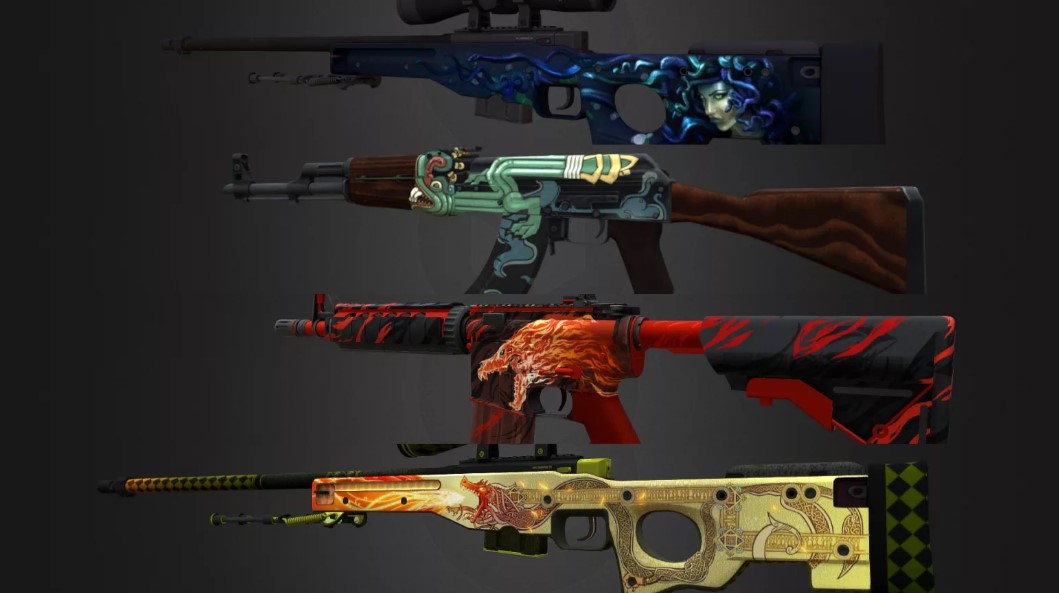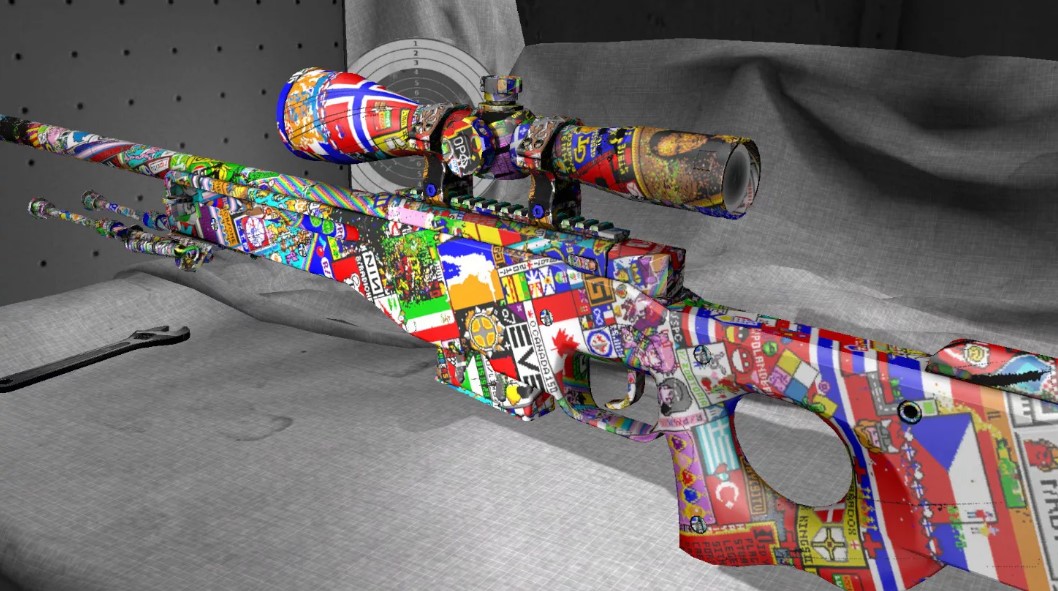
“Skins” in video games, including Counter-Strike: Global Offensive (CS:GO), are cosmetic features that don’t impact the gameplay. They’re essentially different designs or themes for a player’s character, weapons, or equipment. Skins are a common feature in many modern video games, especially those that involve multiplayer online gameplay.
In CS:GO, skins were introduced in the Arms Deal update in August 2013. The reasons behind their introduction are multifaceted.
- Monetization: Video game companies are businesses that need to generate revenue to sustain themselves and fund future development. Skins in CS:GO can be bought and sold on the Steam marketplace, with Valve (the company that developed CS:GO and operates Steam) taking a cut of each transaction. This provides a steady source of revenue. Additionally, skins can also be obtained through in-game purchases of weapon cases, which require keys to open, another purchasable item.
- Player Engagement: Skins add another level of engagement to the game. They offer a form of progression, as players often want to acquire rare or high-status skins. This can motivate players to spend more time playing the game, increasing their engagement and attachment to the game.
- Individuality and Expression: Skins allow players to customize their in-game appearance and show off their personal style or achievements. This can enhance the sense of immersion and investment in the game, as players often appreciate the ability to differentiate themselves from others.
- Community Involvement: Valve has allowed players and fans to create their own skin designs, some of which are incorporated into the game. This helps to keep the community engaged, as players who aren’t creating skins themselves may still enjoy seeing and using new designs from their fellow players.
- Economy and Trading: The introduction of skins led to the development of a robust trading economy within the CS:GO community. Some players enjoy the game not only for the competitive first-person shooter elements but also for the economy and trading aspect, where they can potentially earn a profit from trading rare skins.
Monetization
Monetization in video games, especially in free-to-play or freemium models, has been a significant aspect of the modern gaming industry. In games like Counter-Strike: Global Offensive (CS:GO), this often takes the form of microtransactions, where players can purchase in-game items or features with real money.
In the context of CS:GO, skins were introduced as a form of monetization. Here’s how it works:
- Purchase from In-Game Store: Players can buy skins directly from the in-game store for real money.
- Loot Boxes: CS:GO has a system where players can buy “keys” to open “cases” that they get during the gameplay. These cases contain random skins, and the rarity and value of the skins vary. This introduces an element of chance or luck, as getting a rare, high-value skin from a case can be exciting and rewarding. However, the key to open the case needs to be purchased with real money.
- Steam Marketplace: Skins can be traded or sold on the Steam Marketplace, which is a digital market for buying and selling in-game items from various games, including CS:GO. Valve Corporation, the creator of CS:GO and the Steam platform, takes a cut from every transaction on the marketplace, generating significant revenue.
- Battle Passes: In many games, there are seasonal or thematic “battle passes” or “operations” which players can purchase. Completing various challenges or playing during the season can yield additional skins and rewards.
Overall, skins provide a source of ongoing revenue for Valve. They allow the company to monetize CS:GO beyond initial game sales, sustaining the game’s continued development and updates. Importantly, since skins are purely cosmetic and don’t offer gameplay advantages, this form of monetization avoids the “pay-to-win” criticisms often leveled at other forms of in-game purchases.

Player Engagement
Player engagement is a critical aspect of video game development and design. The more engaged players are, the more likely they are to continue playing the game, recommend it to friends, and even spend money on in-game items or features. In Counter-Strike: Global Offensive (CS:GO), the introduction of skins has played a significant role in enhancing player engagement.
Here’s how:
- Progression and Achievement: Skins can be seen as a form of progression or achievement. By playing the game, players have the chance to earn new skins, either through drops, case openings, or other means. Earning a rare or highly sought-after skin can provide a sense of accomplishment and progression, motivating players to keep playing.
- Customization and Personalization: Skins allow players to customize their in-game appearance. This can enhance the player’s sense of identity and ownership in the game. The ability to choose a skin that matches their personal taste or style can make the game more immersive and personal, increasing engagement.
- Social Interaction and Competition: Skins can be a form of social interaction and competition among players. Players might want to show off their rare skins to others, leading to a form of social status within the game community. This can lead to friendly competition among players to acquire rare skins, keeping players engaged over time.
- Variety and Freshness: The regular addition of new skins helps keep the game fresh and interesting. It gives players something new to look forward to, even if the core gameplay remains the same. This sense of variety and novelty can help maintain long-term player engagement.
- Economy and Trading: The introduction of skins led to the development of a robust trading economy within the CS:GO community. Some players enjoy the game not only for the competitive first-person shooter elements but also for the economy and trading aspect, where they can potentially earn a profit from trading rare skins. This extra layer of gameplay can keep players engaged for longer periods.
So, in short, the inclusion of skins in CS:GO creates a more engaging, personalized, and immersive gaming experience, helping to maintain and increase player engagement.
Individuality and Expression
In the world of gaming, especially multiplayer games, individuality and self-expression play crucial roles in enhancing player engagement and satisfaction. Skins, like those found in Counter-Strike: Global Offensive (CS:GO), serve this purpose by allowing players to customize their in-game characters and equipment, thus reflecting their unique identity or style.
Here’s how skins in CS:GO facilitate individuality and expression:
- Personalization: Skins let players modify the appearance of their characters or weapons in ways that reflect their personal taste or style. This could be a reflection of their favorite colors, patterns, or themes, or it could be a way to match their in-game appearance with their gaming alias or persona.
- Achievement and Status: Certain skins are rare or difficult to obtain, and displaying such skins can be a mark of achievement or status within the game. Some players take pride in collecting these rare skins and showing them off during matches. This allows them to express their dedication to the game and their success within its in-game economy or reward system.
- Immersion and Role-Playing: Skins can enhance the role-playing aspect of the game. Players can choose skins that align with the ‘character’ they want to play, which can make the game more immersive and fun. For example, a player might choose a military-themed skin to feel more like a professional counter-terrorist operative.
- Community Connection: CS:GO’s skin system includes designs created by community members. Owning and displaying these skins can be a way for players to express support for their favorite designers or to feel more connected to the game’s community.
In sum, skins in CS:GO give players a way to differentiate themselves from others, display their achievements and tastes, and feel more connected to their character and the game’s community. By offering a method for self-expression, skins can make the game more engaging and personal for each player.
Community Involvement
Community involvement plays a vital role in sustaining the longevity and relevance of video games, especially those in the multiplayer and competitive domains like Counter-Strike: Global Offensive (CS:GO).
The introduction of skins has significantly encouraged community involvement in CS:GO.
- Community Creations: Valve, the developer of CS:GO, has a platform called the “Steam Workshop” where community members can create and submit their own skin designs. Some of these community-created skins are chosen to be included in the game, especially in new weapon cases or collections. This encourages creative members of the community to engage deeply with the game, and it allows other players to appreciate and support their work.
- Trading and Economy: The introduction of skins has led to a vibrant player-driven economy in CS:GO. Players trade skins based on their rarity, condition, and demand in the market. There are even third-party websites and forums where players can negotiate trades or sales, discuss market trends, and share their “unboxing” experiences. This aspect of the game fosters interaction and engagement within the community.
- Tournaments and eSports: In the world of eSports, skins can sometimes be used as a form of team branding, where team members use specific skins during competitions. Fans of these eSports teams often use the same or similar skins to show their support. This creates a sense of unity and involvement among players and fans alike.
- Shared Experience and Discussions: The pursuit of rare skins or the excitement when new skins are released creates shared experiences among the player community. Players often engage in discussions about the best-looking skins, the value of skins, or even the “luck” involved in obtaining skins from weapon cases. These discussions take place in various online community spaces, including game forums, social media, and video platforms.
In these ways, the introduction of skins in CS:GO has spurred community involvement, making the game more than just a competitive shooter, but also a platform for creativity, economics, shared experiences, and social interaction.
Economy and Trading
The introduction of skins in Counter-Strike: Global Offensive (CS:GO) has led to the creation of a complex and vibrant player-driven economy.
Here’s how the economy and trading system in CS:GO works:
- Acquiring Skins: Players can acquire skins in a number of ways. They can be randomly dropped at the end of a game, purchased directly from the in-game store, or obtained from opening weapon cases with purchased keys. The weapon cases and the resulting skins have different levels of rarity, contributing to their market value.
- Steam Marketplace: The Steam Marketplace, run by Valve Corporation, is the primary platform for trading skins. Players can buy and sell their skins on this platform. The prices for skins fluctuate based on supply and demand, much like a real-world economy. Valve takes a cut from each transaction, generating revenue.
- Trading Between Players: Players can also trade skins directly with each other. This is often done to exchange multiple lower-value skins for a single high-value skin, or to acquire specific skins that a player wants for their personal collection.
- External Trading Platforms and Gambling Sites: Beyond the Steam Marketplace, there are third-party platforms where players can trade, buy, or sell skins, often for real-world money instead of Steam Wallet funds. These platforms operate outside of Valve’s control, and they can sometimes be controversial, especially those associated with gambling.
- Investment and Speculation: Some players buy skins as an investment, hoping that their value will increase over time. For example, a discontinued skin might become more valuable as it becomes rarer. This speculation and investment aspect adds another layer to the game’s economy and can be an engaging part of the game for some players.
In all these ways, skins have created a dynamic and intricate economy within CS:GO. For some players, trading skins can become as engaging as the game itself, if not more so. However, this also comes with risks, especially around gambling and scams, and Valve has had to take measures to address these issues.
Skins allowed to spin guns
The “gun spinning” or “weapon inspect” feature in CS:GO allows players to visually inspect their equipped weapon (and its skin) from various angles. This feature doesn’t provide any gameplay advantage, but it adds a layer of depth to the aesthetic experience of the game. It enables players to fully appreciate the design and details of their weapon skins, enhancing their personal enjoyment and the value of these cosmetic items.
To inspect a weapon in CS:GO, players can press the ‘F’ key by default, which will cause the player character to hold up and rotate the weapon, giving a full view of the skin. This can be done at any time during a game, but of course, it doesn’t pause the game, so players still need to be aware of their surroundings!
The introduction of skins indeed made this feature more significant. Without skins, every weapon of the same type would look identical, making the inspect feature much less interesting. But with skins, every player can have a uniquely styled weapon, and the ability to inspect these weapons in detail adds to the fun and satisfaction of collecting skins.
All the bright skins have been made rare
In Counter-Strike: Global Offensive (CS:GO), the rarity of a skin isn’t necessarily linked to its color brightness. However, it is a common practice in many games, including CS:GO, to make visually striking or unusual skins more rare.
This is done for a few reasons:
- Visual Distinction: More rare skins are designed to stand out. This makes them more desirable to players, as they offer a unique way to customize their in-game appearance. Bright or flashy skins are certainly eye-catching, so they often fall into this category.
- Perceived Value: By making the more visually distinctive skins rare, they become more valuable within the game’s economy. Players are often willing to spend more money or effort to acquire these rare skins, which helps drive the game’s microtransaction system and player trading.
- Reward and Prestige: Owning a rare skin can be seen as a status symbol within the game community. If the rare skins are also visually striking, this makes the status symbol even more noticeable. It can feel rewarding for players to show off their rare, bright skins in a match, demonstrating their dedication to the game or their luck in obtaining the skin.
It’s important to note that not all bright skins are rare, and not all rare skins are bright. The rarity of skins in CS:GO is determined by their grade (from Consumer Grade to Covert), and this is independent of their color scheme. However, many of the most popular and desired skins do have distinctive and often bright designs.


